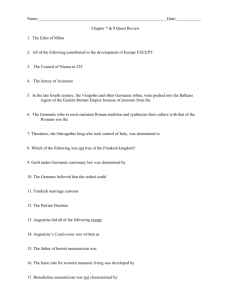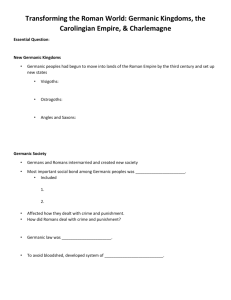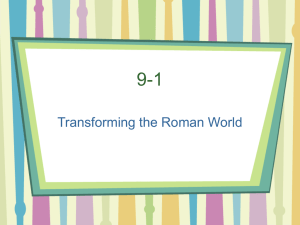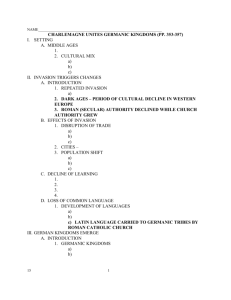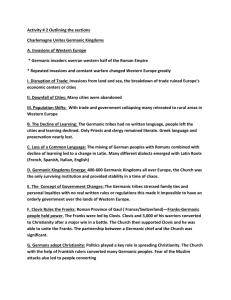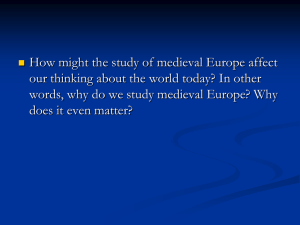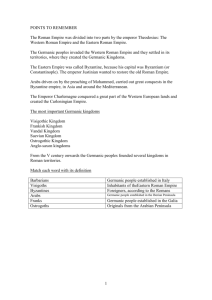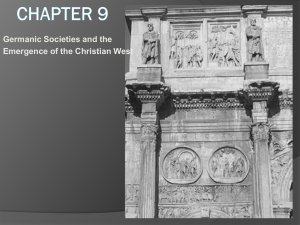Transforming the Roman World Ppt.
advertisement
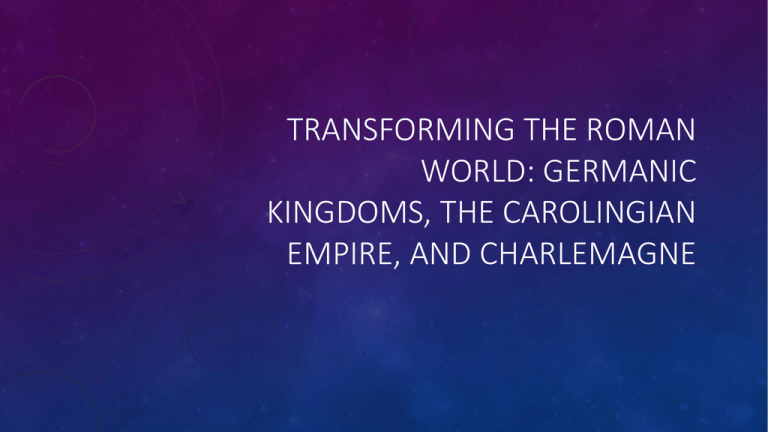
TRANSFORMING THE ROMAN WORLD: GERMANIC KINGDOMS, THE CAROLINGIAN EMPIRE, AND CHARLEMAGNE DO NOW: • Grab a textbook and use the map on page 303 to answer these questions: • Which Germanic kingdoms were the largest in 500? • What Geographic factors kept Constantinople from being conquered? OBJECTIVE/ESSENTIAL QUESTION: COPY ONTO NOTES SHEET • How did Germanic tribes transform the Roman Empire? NEW GERMANIC KINGDOMS • Germanic peoples had begun to move into lands of the Roman Empire by the third century and set up new states • Visigoths: occupied Spain and Italy • Ostrogoths: took control of Italy from the Visigoths in the 5th century • Angles and Saxons: tribes from Denmark and northern Germany that moved into Britain • Eventually became the Anglo-Saxons GERMANIC SOCIETY • Germans and Romans intermarried and created new society • Most important social bond among Germanic peoples was family • Extended family including aunts, uncles, cousins, and grandparents • Worked land together and passed it down to future generations • Provided protection in violent atmosphere of the time • Affected way Germanic law treated crime and punishment • How did Roman system deal with crime and punishment? • Germanic law was personal: injury by one person against another resulted in blood feud between families and savage acts of revenge. • To avoid bloodshed, new system developed called wergild • A fine paid by wrongdoer to family of person he/she injured or killed • Value of a person in money • Varied according to social status KINGDOM OF THE FRANKS • Only German state on European continent that lasted long time • Frankish kingdom established by Clovis • Strong military leader • 500 A.D. became first Germanic ruler to convert to Christianity • Won him support of the Catholic Church • Covered modern day France and western Germany • Defeated surrounding Germanic tribes and unified Franks as a people • After Clovis’ death, sons divided kingdom among themselves CHARLEMAGNE AND THE CAROLINGIAN EMPIRE • During 600s and 700s, Frankish kings gradually lost power to their officers • One of them, Pepin, assumed kingship for himself and his family • 768: Pepin dies and his son, Charles the Great or Charlemagne, becomes new Frankish king • Ruled from 768-814 • Fierce warrior, strong statesman, devout Christian • Greatly expanded Frankish kingdom and created the Carolingian Empire • Covered much of western and central Europe at its height • Most powerful Christian ruler • 800: acquired title Emperor of the Romans • Symbolized joining of Roman, Christian, and German elements THE END OF THE CAROLINGIAN EMPIRE • Carolingian Empire weakened from within by division after Charlemagne’s death and from outside by enemy attacks • From within: • 814: Charlemagne dies • Less than 30 years later, empire divided among his grandsons into 3 major sections • West Frankish lands • Eastern Frankish lands • Middle Kingdom • Local nobles gained power while Carolingian rulers fought each other • From outside: • Ninth and tenth centuries, western Europe experienced wave of invasions • Invaders • Muslims attacked southern coasts of Europe up to southern France • Magyars, people from western Asia, moved into Central Europe, settled in Hungary and invaded western Europe • Vikings, Germanic people from Scandinavia, most far-reaching attacks THE VIKINGS • Sacked villages and towns, destroyed churches, defeated small local armies • Warriors, superb shipbuilders, and sailors • Their ships were the best of the period • Dragon ships • Long and narrow with beautifully carved, arched prows • Carried 50 men • Construction allowed them to sail up European rivers and attack places far inland
